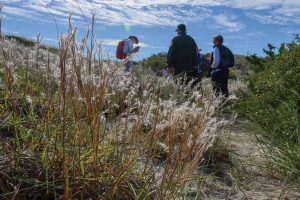The crystal skipper (Atrytonopsis quinteri) is a rare butterfly. In fact, it is so rare, it’s only found on the Crystal Coast in North Carolina, specifically, a region stretching from Fort Macon State Park to Hammocks Beach State Park. Long thought to be a variation of the Loammi skipper (A. loammi) which is found farther south, it was identified as its own species in 2015. As with many insects, the crystal skipper relies on specific plants for survival, especially its host plant, seaside little bluestem (Schizachyrium littorale) and other plants in the barrier island dune system that provide nectar.
The state parks at either end of the skipper’s range have an adequate supply of seaside little bluestem and will not be developed anytime soon. But coastal development, landscaping choices, and increased storm intensity have diminished dunes in both number and health. Along most of the islands, patches of seaside little bluestem remain to support the skipper and are important for connecting populations via “stepping stones.” Dune restoration efforts often provide recreational uses and storm protection but have little focus on inner dune vegetation, resulting in less habitat for the skipper.
A survey conducted by North Carolina Aquariums and NC State University as part the Coastal Landscapes Initiative found a decrease in seaside little bluestem from 2018 to 2019. The losses were likely a result of scouring during Hurricane Florence, and overwash from the hurricane also left significant bare ground at several sites. This study did not count all nectar plant populations, but it is probable some also experienced decreases. The coinciding skipper surveys showed fewer butterflies during the spring and summer flight periods.
To ensure a thriving crystal skipper population in the future, it is important to preserve and restore their host and nectar plants, however, seaside little bluestem and nectar plants are not readily available from nurseries. This is where the North Carolina Botanical Garden and our Native Plant Materials Development Program (NPMDP) come in.
Species of plants can vary regionally. For example, a butterfly milkweed plant in Wisconsin has adapted to the climate of the upper Midwest. Its seeds may not be able to survive and grow well in North Carolina. It is important to restore landscapes with seeds that are genetically appropriate to the space, even within species.

The NPMDP is working to collect local seed and propagate plants for use in local restoration efforts throughout North Carolina. So, last fall, with cooperation and a collecting permit from NC State Parks, NCBG staff Mike Kunz and Emma Marzolf, NCBG interns, Gloria Putnam from NC Sea Grant, Carol Price from NC Aquariums, and Ben Fleming from NC State Parks collected seed at Fort Macon State Park. Funding was provided by NC Sea Grant. These seeds have been cleaned, stored, and propagated here at NCBG. Trays of seaside little bluestem and nectar plants are growing in Chapel Hill, and they will move to their new home along the coast this fall to restore degraded dunes and hopefully provide habitat for skippers next spring.
In addition to planting habitat for the skipper, education is also an important part of this project. Landowners, including owners of beach houses and hotels, don’t usually landscape with native plants. This project seeks to illustrate that home and hotel landscapes are part of the larger conservation picture, encouraging landowners to develop a landscape that supports the local ecosystem in addition to looking beautiful.
To do this, the group is establishing a highly visible dune skipper plant garden, and they will present information to landowners through presentations to garden clubs and resources for master gardeners. Since dune plants are usually not available for purchase, the goal will be to encourage landowners to recognize the beauty and importance of native plants and to maintain habitat that is already in place.
Restoring native vegetation to the dunes is just one piece of the puzzle to conserve the crystal skipper. Several research questions remain, and would make excellent projects for interested graduate or undergraduate students. “We are especially interested in how hurricanes affect the skippers and aim to support their recovery after storms with targeted habitat restoration in case they can’t manage on their own,” says Price. “Ian Grace, one of my NC State University student interns, laid the groundwork for this research. We could really use a student to take the reigns of this project as their first priority.”
This project was funded by a grant from NC Sea Grant and supported by the NPMDP at NCBG. NC Sea Grant, NC Aquariums, NCBG, NC State Parks, NC State University, the US Fish and Wildlife Service, and the Master Gardeners Program collaborated on this project.
Top image: The crystal skipper is named for both the region is it found in (the Crystal Coast of North Carolina) and for the white, crystal-like markings on its wings. Photo by NC Aquariums
